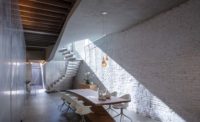Bilzen, Belgium
It can be done: a wheelchair-friendly environment that in no way resembles the typical one. The Belgian firm C.T. Architects designed an accessible apartment for an accident victim in a small north-Belgium town, yet there is nothing about it that even hints at the owner's having a disability. And while many of the design solutions here were inspired by necessity, they would be just as apt—and welcome—in any urban microloft.
“Before the client's car accident, the family already owned a parking space on the ground floor of this building,” explains architect Nick Ceulemans, principal in charge. “Then they bought the rest of the floor (used largely for storage) and commissioned me to convert the full 820 square feet into a living space. It was their specific wish that it not look at all like a dwelling for a physically challenged person.”
The process of design and construction took one and a half years. The repurposing of the ground floor to make an accessible residence entailed changing the main entrance to create a ramp to the client's front door, a new communal entrance for the upstairs neighbors and—within the common hallway—a second entrance into the client's apartment for caregivers and other related professionals. Visitors using this door first enter a pantry cum wheelchair storage area, and from there they go into the kitchen.
Ceulemans and his design team organized the long, narrow apartment into a conventional succession of increasingly private spaces: living room and dining area, a central corridor—at a comfortable width for wheelchair passage—with an efficient kitchen on one side and the bathroom on the other, and then the bedroom/study in the rear. Daylight enters both from the windows facing the street in front and through the sliding glass doors that lead seamlessly out onto a small back terrace. A panel of translucent plastic slides across for privacy in the bedroom, while rough-sawn oak floors—covering a hydronic under-floor heating system—and white walls and ceilings throughout create a sense of unity and calm.
A model of efficiency, the kitchen, designed by the architects, would thrill any small-apartment dweller. Electrically height-adjustable, it features a countertop that shifts from a standard 37 inches to an accessible 28 inches from the floor and upper cabinets that lower to meet the counter, where the faucet can be pushed down flush with the sink. Shallow storage bins hidden under the cabinets pull down for quick access to things like herbs and coffee. This mobility provides a wheelchair-bound user with the ability to reach everything easily, and closes off the cooking area from view when desired.
For ambient illumination in the lengthy corridor, and to add a decorative touch, Ceulemans tucked a run of LED lighting into coves above the kitchen and doors—operable by remote to change the color and intensity. Then, he concealed the refrigerator, wall oven, housewares, and clothing storage behind sliding panels, made of the same wood as the floors, to minimize clutter. The architect says that sliding doors work better for the client, whose sense of balance suffered in the accident, than doors that swing open. The design team also carved deep grooves in the wooden panels instead of using doorknobs or handles, which can be difficult to grasp. They did add two cupboards, across from the cooktop and counter, whose doors do not slide, however, but rather pull out for easy access to stored foodstuffs.
In order to provide optimum functionality for the unit's modest bathroom, the architect created two zones: one with the toilet and washbasin, the other with the shower and a washer/dryer. These are separated from each other by a large panel that rotates to close the laundry area off from view. In keeping with the minimalist aesthetic, he also reinforced the towel rack and hand-shower rod to make them reliable substitutes for the typical grab bars so often found in baths for the disabled or elderly.
As one of the firm's disciplines includes product design, Ceulemans devised key pieces of furniture to comply with Belgian disability codes and to accommodate the client's specific needs and preferences. For instance, he outfitted the dining table with built-in shelves at both ends and configured it so that it juts at an angle toward the kitchen—not just because it looks cool but because, by doing so, it complies with the maximum distance allowed between stove and table. He also created the flexible swing-arm wall lamp above the table, which was presented at this year's Salone del Mobile in Milan. In the bedroom, the architect was responsible for a double-duty bed that is also a desk at its head; an adjacent wall of bookshelves; and a hybrid light fixture/electrical hub that swivels to illuminate both bed and work surface, as well as to provide outlets at a convenient height for the user.
Before starting a practice in 2009 with his wife and partner Liesbet Thewissen, an architect and urban planner, Ceulemans had worked for well-known firms in Amsterdam and London such as Wiel Arets, David Chipperfield, and Zaha Hadid. But his thoughtful and ingenious solutions for this compact apartment will probably do more than his résumé to establish a reputation—while providing his client with a unique living environment.
Consultants: GeWoon Interior Architects (interiors); Alelek (lighting)
Size: 1,040 square feet (includes common entrance and terrace)
Cost: $200,000
Completion date: December 2012
People
Architect:
Consultants:
Size:
Cost:
Completion date: |
Products
Glazing:
Doors:
Hardware:
Fixtures & fittings:
Surfaces:
Furniture:
Lighting: |









Post a comment to this article
Report Abusive Comment